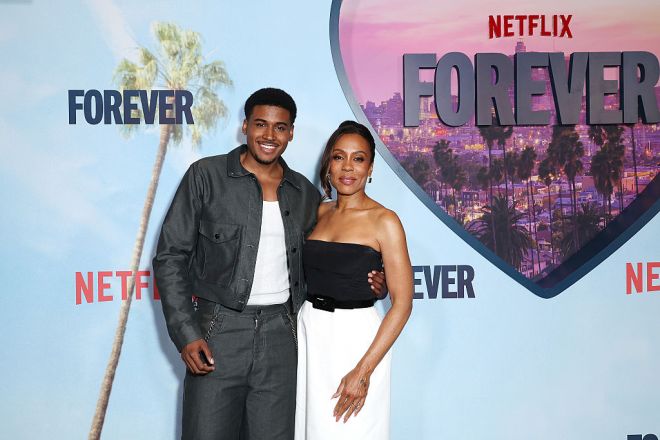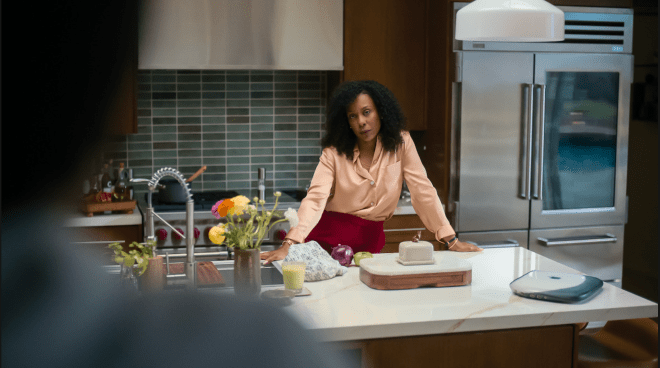Does Dawn from 'Forever' Have ADHD?
Seeing Myself In Dawn: Netflix’s ‘Forever’ Quietly Mirrors Black Women With ADHD Desperate To Look ‘Normal’ [Op-Ed]
Share the post
Share this link via
Or copy link

When I watched Netflix’s Forever (for the third time now), one scene stopped me in my tracks. In the Martha’s Vineyard episode, teen protagonist Justin unexpectedly shares a new music track with his mother, Dawn Edwards. It’s a tender moment on the surface: a heartbroken son hoping his mom will connect with something he’s passionate about. Dawn’s warm, proud smile didn’t last too long. Instead, she responds with anxious concern, furrowing her brow and offering pragmatic questions rather than simply vibing with her son’s music. As I sat on my couch, I felt a jolt of recognition. I found myself asking out loud, “Wait…does Dawn have ADHD, too?”
Forever is Netflix’s drama from Mara Brock Akil, loosely based on Judy Blume’s 1975 novel. The most stark difference from the original text is something no one can miss: this version is fully rooted in Black reality. It follows high school sweethearts Justin and Keisha as they navigate first love, but it’s just as much about their families. The show peels back the layers on legacy, pressure, and how Black parents—especially moms like Dawn Edwards—try to prepare their kids for a world that doesn’t play fair.
Related Stories
The series explicitly tells and reminds us that Justin has ADHD, but it never says the same about Dawn. Played by Karen Pittman, Dawn is portrayed as the consummate Black woman: polished, college-educated, corporate and a devoted mother of two. On paper, she doesn’t fit the stereotypical image many people have of attention deficit hyperactivity disorder. Yet, as a Black woman who was diagnosed with ADHD in middle school, I recognized Dawn’s behavior in that scene—and throughout the series—as eerily familiar. Her rigid scheduling, her tendency to over-prepare, her need for control and difficulty with flexibility…these are traits I know all too well. Watching Dawn struggle to simply be present and emotionally in the moment with Justin’s music felt like looking in a mirror. It was the spark that led me to wonder if Dawn Edwards is an ADHD-coded character, a representation of the kind of neurodivergent Black woman rarely seen on screen.
RELATED CONTENT: ‘Black = Culture’ Celebrates Black Television And Film Pioneers Mara Brock Akil And Malcom D. Lee
Twice as Good, Twice as Tired—Masking ADHD Under Perfectionism
Love MadameNoire? Get more! Join the MadameNoire Newsletter
We care about your data. See our privacy policy.
Growing up Black and female, I learned early that excellence wasn’t optional—it was expected. There’s a familiar refrain in many Black households (immortalized by Papa Pope’s line to Olivia on Scandal): “You have to be twice as good to get half of what they have.” This ethos of needing to be twice as good fueled my upbringing. I threw myself into overachievement, determined to outshine any doubt about my capabilities. I wasn’t just up against ADHD. I was often the youngest and smallest in my classes. I had something to prove. Beneath that “smart girl” surface, I was also a girl grappling with ADHD. The diagnosis came in middle school, yet instead of feeling relief, I felt a quiet shame—a fear that having ADHD made me “less than.” So I hid it. I refused special accommodations in class, convinced that if I worked twice as hard and did my best to stay organized, no one would ever suspect I was struggling. In my mind, needing help was not an option; I had to do it all, and do it flawlessly.
Looking back now, I realize I was far from alone in this coping strategy. Many successful Black women with ADHD become experts at concealing their disorder behind a veil of hyper-competence. We overcorrect and overprepare. We obsess over every detail, masking our ADHD symptoms with perfectionism and hustle. We might spend hours editing a single email or create elaborate color-coded schedules for ourselves and our families. We will work twice as hard as everyone else just to feel like we’re keeping up. On the outside, we look like we have it all together—the career, the organization, the drive. We’re often exhausted, constantly playing catch-up while masking what we’re truly going through. This pressure to meet both cultural expectations and our own high standards means our ADHD often flies under the radar or gets dismissed entirely. After all, if you’re still meeting deadlines and hitting goals, nobody stops to ask if you might be struggling underneath the surface. It’s that classic ADHD dance: procrastinate out of overwhelm, then hyperfocus till 3 a.m. to pull off a great result. It’s a cycle that’s rarely recognized as ADHD when you’re still achieving on paper.
ADHD in Black Women: Hidden in Plain Sight

Black women and girls with ADHD have long been overlooked, misdiagnosed, or simply written off. I was lucky (and unusual) to get my diagnosis as a tween. Research shows that far too many Black girls never get that validation. A 2023 large-scale analysis of over 800,000 patient records found stark racial and gender disparities. White patients were about 26% more likely to be diagnosed with ADHD and 61% less likely to be tagged with a conduct disorder, compared to Black patients. Among all demographics, Black women and girls were the least likely group to receive an ADHD diagnosis. In other words, Black girls showing the same symptoms as others are often not identified as having ADHD at all. Instead, they’re more likely to be labeled with behavioral problems or “conduct disorders,” effectively pathologized as difficult or defiant rather than given the support of an ADHD diagnosis.
Reading those findings hit home for me. It explained much about why I felt I had to reject formal accommodations and prove I didn’t need help. Society–and even some educators–already had lower expectations (or harsher judgments) for Black girls. If we struggled to pay attention or stay organized, it wasn’t seen as a brain-based disorder. It was seen as a character flaw, an attitude problem, a lack of discipline. So we learned to compensate. We internalized the “twice as good” mandate to avoid being written off as “half as good.” We became the Dawns of our own lives: hyper-capable on the outside, tightly controlling every variable to keep chaos at bay.
Hyperfocus, Control, and the Fight to Be Present
One hallmark of my ADHD is something that surprises people: hyperfocus. When a task or passion grabs my attention, I can lose myself in it for hours. The rest of the world fades away. It’s the flip side of struggling to focus on things that don’t interest my brain. I saw hints of that in Dawn, who channeled a similar intensity into maintaining order and success. Whether it’s planning Justin’s college applications or managing the family’s day-to-day, she zeroes in with laser focus. The college argument with Justin, in which she shared that her way was going to be the way, was a sign of how controlling she feels she must be. Watching that, I flashed back to my color-coded high school planner and the way I micromanaged group projects in college. I was terrified something might go wrong if I didn’t oversee every detail. Control, in many ways, became my coping mechanism. If I could orchestrate my environment perfectly, maybe my brain wouldn’t betray me with forgotten deadlines or misplaced papers. Maybe I could prevent the kind of last-minute scrambles my ADHD so often created in my chaos.

Of course, the other side of that control is difficulty with flexibility. Any unexpected change or unplanned moment can feel destabilizing. Dawn’s need for things to go “according to plan” sometimes makes her come off as rigid or unfeeling, like in that first moment of the series, where she was unrelenting about Justin going out for New Year’s Eve. On this third watch, I empathized with her deeply here. ADHD doesn’t just impact attention; it often comes with challenges in emotional regulation. Emotions can run high and fast, and we can react in ways that look cold or overly anxious when we’re just overwhelmed. In that moment, Justin only felt that his mom was on his case. It’s a painfully accurate depiction of the kind of miscommunication that can happen when ADHD brains struggle to be present in real time. We’re often one step ahead (worrying about the future, imagining problems that haven’t happened) or one step behind (distracted by something we can’t let go of), and we miss the moment right in front of us. In Dawn, I see a woman who loves her son fiercely—she wouldn’t be so strict if she didn’t care—but who has a hard time emotionally connecting in certain moments because she’s caught up in her mental traffic jam. As ADHD experts note, heightened emotional sensitivity and frustration are common in those of us with the disorder. We feel so much, but expressing it at the right time, in the right way, can be a battle.
Seeing Dawn Was a Rare Moment of Validation
By the end of Forever, I realized that Dawn Edwards gave me something I didn’t know I needed: representation that validates the existence of Black women with ADHD, in the way many of us show up. Here was a character who, to all the world, looks like the archetypal “Strong Black Woman.” She’s accomplished, elegant, always on top of everything—yet her behaviors quietly screamed neurodivergent to me. Whether Mara Brock Akil (the show’s creator) intended it or not, Dawn reads as a Black mom who might very well share her son’s ADHD. The beauty of it is that Dawn is not a caricature or a punchline. She’s not the ditzy stereotype sometimes used for ADHD characters. Instead, she’s the one holding it all together…until the cracks quietly show. For me, a Black woman who has lived this double life of outward “perfection” and inner chaos, seeing Dawn felt like being seen. It was as if the show reached out and whispered, “You are not the only one. There are others like you, even if nobody has said it out loud.”
RELATED CONTENT: The ‘Aha’ Moment: Black Mothers Of Neurodivergent Children Are Discovering More About Their Own Mental Health
That validation matters so much. Black women are rarely afforded the grace to be openly neurodivergent on screen. In real life, countless Black women navigate undiagnosed ADHD or other mental health challenges while wearing the mask of having it all together. The cost of that invisibility is high: it’s loneliness; it’s burnout; it’s feeling like you’re failing even when you’re succeeding. That’s why a character like Dawn is revolutionary in a subtle way. Forever gave us a Black mother who is hyper-capable yet hyper-vigilant, loving yet occasionally lost in her own head. She doesn’t fit the one-dimensional trope of the “Angry Black Mom” or the “Strong Black Matriarch” who never bends. Instead, she’s nuanced—sometimes wrong, sometimes fragile, and possibly, quietly, neurodivergent.
It made me wish I’d seen someone like her when I was a little Black girl with an ADHD diagnosis feeling too…different. It made me hope that somewhere out there, another Black woman watching Forever had the same lightbulb moment I did and felt a little less alone.
More Nuanced Portrayals, Please

Dawn’s character opened the door to a long-overdue conversation about Black women and neurodivergence. We need more Dawns on screen. More characters who reflect the reality that ADHD (and autism, and anxiety, and so on) can and do exist in Black women, even those who seem to be “handling everything.” We need storylines that move beyond the tired trope of the overbearing Black mom or the superwoman who never cracks, and show the why behind those behaviors with compassion. Perhaps if we saw more of these nuanced portrayals, fewer Black girls would slip through the cracks undiagnosed. Perhaps the world would start to understand that when a Black woman is controlling or overly driven, she might be coping with something internally, not just fulfilling a stereotype.
As someone who has lived it, I’m grateful for the glimpse of it in Dawn. I’m hopeful that with continued representation, Black women with ADHD won’t have to hide in plain sight forever.
RELATED CONTENT: Mompreneurs: Bunnie Hilliard Elevates Representation With Brave + Kind Books
Related Tags
ADHD in Black women ADHD masking black mental health Black moms on TV black parenting Dawn Edwards emotional regulation ADHD Forever Netflix Forever on Netflix mara brock akil Netflix Forever neurodivergent Black women-

My Husband And I Attempted To Have A Creative Date Night At Home -Without A Babysitter - Here's How It Went
-

She Tried It: Ivy Park Drip 2 and 2.2 Black Pack
-

Vontélle Eyewear Founders Score History-Making Licensing Deal With Paramount
-

Our Health, Our Power: Debunking Myths And Taking Charge This Open Enrollment




